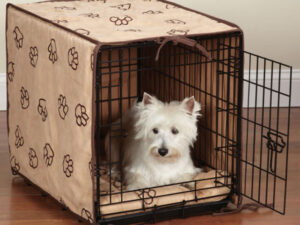Crate Training Your Puppy Today
Puppies are cute and fun but they can be little terrors, too. There is something useful you can teach your puppy that will come in handy in many ways in the future. That is crate training.

Some people don’t like crating dogs and think that it’s “cruel” but that’s usually because a crate looks like doggy jail to them and they don’t understand what it’s really like for a dog. For a dog that’s been correctly crate-trained, their crate is their private area. It is a dog den, an area where they can go to get away from noise and people in the house and take a nap or chill out. Their crate is a place where a dog can relax.
Crate training is something that all dogs should learn. It’s a good way to help your puppy with his house training. Some people like for their dog to ride in the crate in their vehicle for safety. And, if you have a larger dog, then your dog will need to ride in a crate if you take your dog on a plane. So, learning about crate training as a puppy is important for a dog.
Choosing a Crate
In order to crate train your puppy you should start by choosing a crate. There are basically two kinds: a hard, plastic airline crate or a collapsible wire crate. An airline crate gives your dog more privacy and it is safer if you travel with it in your vehicle. A wire crate lets your dog see more and you can fold it up and take it with you if you are going to a training class, for example. Both kinds of crate are fine for crate training and they cost about the same so you can choose whichever one you prefer for training in your home.
It’s usually a good idea to choose a crate that will fit your puppy when he is an adult dog. That way you won’t have to buy another crate in just a few months. If the crate is much too large for your puppy right now then you can buy a divider to make the crate smaller so your puppy will be cozy in the crate. There are usually suggestions on the side of the box or on the tags of the crate that tell you what size to get for which breeds.
Don’t get an excessively large crate for your dog (at his adult size) if you intend to use the crate for travel or for a plane ride. Crates should just allow your dog enough room to stand up, turn around, and lie down comfortably. If there is more room than that then your dog can be tossed around in the crate in the event of an accident and he could be injured.
Time for Crate Training your Puppy
Once you have chosen a crate you should bring it home and place it in an area where your puppy will notice it and where it won’t be isolated. Put it someplace where your puppy often lies down or plays. You should open the door and place some towels or a mat in side. Put some toys and treats in the crate and leave the door open.
Don’t push your puppy into the crate but allow him to check it out on his own. You should leave the door open and let the puppy go in and out as he pleases. Keep putting treats in the crate and make it a fun place for your puppy. If he wants to sleep in the crate, that’s fine. Don’t close the door on him.
After a day or so of allowing your puppy to get used to the crate you can place more treats and toys in the crate and close the door when your puppy is inside. Make sure that your puppy can see you and stay near the crate. After a few minutes you can let the puppy out and praise him for being good. Repeat this activity several times a day for two or three days. You can gradually lengthen the amount of time the puppy is staying in the crate but stay near the crate so the puppy knows you are nearby.
After a couple of days you can start going about your business in the house while the puppy is in the crate. It can become an ordinary event for the puppy to spend a little time in the crate while you are doing things. Remember to always praise the puppy when you release him.
You can eventually step outside the house for a few minutes and then return to let the puppy out of the crate. If you continue to do these things in increments, then your puppy should not object to you being away for a few minutes. Continue to increase the amount of time you are away from the crate. After a few days your puppy should be crate trained. Your puppy may cry or protest at some point but this is normal. If he has treats and toys then he should be able to comfort himself and you will return in a few minutes.
This is a nice, slow way to accustom your puppy to the crate. Some people prefer to put their puppy in the crate overnight without any preparation, with the crate next to their bed. Most puppies will cry for part of the night if you do it this way.
With whatever way you crate train your puppy, it is important that he learns about crate training, so give it a try and see how he likes his crate.
